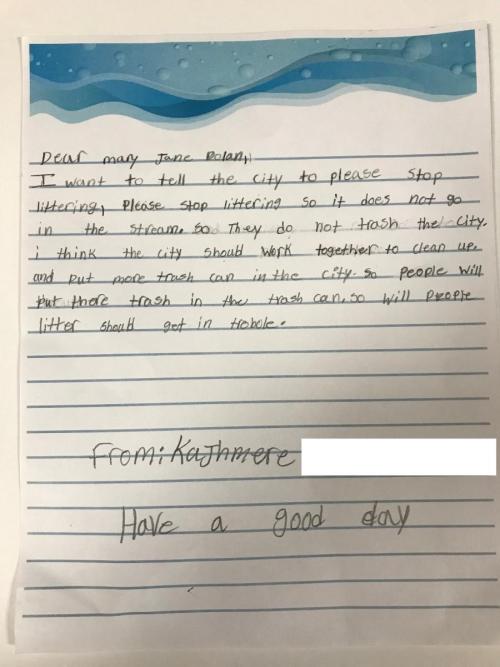School-Based Meaningful MWEEs Maximize Impact!

eeBLUE: Watershed Chronicles
This post was written by Lilly Meighan, education and outreach coordinator of Lynchburg Water Resources.

Squeals of laughter and joy along with nods of understanding and respect ring through the urban forest in Lynchburg, Virginia. A group of fourth and fifth graders trod to a stream tucked behind a riparian buffer. The students leave the school setting behind and venture into the unknown urban stream wilderness, ripe with potential meaningful watershed educational experiences (MWEEs). What these students experience will have an impact on how they look at the environment that surrounds them.
During the summer of 2021, even when facing multiple challenges presented by the COVID pandemic, students participating in 21st CCLC programming provided by Lynchburg Water Resources educators created a meaningful impact on their watersheds. One teacher shared, “students were introduced to so many new aspects of water. They have taken interest in how water is used, conserved, recycled, and reused. Some of the students loved the notion of being a scientist and studying the bugs [macroinvertebrates]. This enrichment will follow them for years.”
At this time, all programming was implemented in person on school property due to COVID restrictions. This allowed for place-based programming, resulting in a program that can be continued without needing funds for transportation. Aside from ease of logistics, school-based learning allowed students to experience the land around their school, community, and local environment through an entirely different lens. After being introduced to watershed science, students tested those concepts in real life to gather their own data at a stream behind their school. Students visited the stream behind their school and tested the water for pH, dissolved oxygen, and turbidity, and searched the stream habitat for environmental indicators (benthic macroinvertebrates!). These experiences resulted in stewardship projects that were entirely student-selected and student-led.
In the summer of 2021, students identified a local watershed problem and implemented a school-based strategy to address that problem. Students identified litter as a real and impending threat to our watershed health—which made an awesome connection to marine debris from a presentation from a NOAA scientist in the following spring!

One group identified a storm drain in their courtyard that transported litter to their local school stream. The students identified the root cause of all the litter in the storm drain: a lack of trash receptacles in the courtyard. As a response, they were able to purchase a trashcan to be placed in that area. Students took it a step further and wrote letters to local government officials asking them to address litter in the watershed and created posters to educate their classmates on the hazards litter can cause. The letters resulted in the Director of Lynchburg Water Resources visiting their school to talk to them about their watershed! In the following spring, students built upon their summer experiences and advocated for minimizing plastic usage (and thus marine debris) by creating classroom planters for their school so their classmates could learn to grow their own food to minimize plastic use.

By completing this program entirely on school property, students were able to see their direct connection to the environment that surrounds them every day and take steps to care for it. We’ve discovered that you don’t have to travel to a remote location to create a meaningful, impactful experience for students. Water is everywhere, you just have to show the connection. Whether that be through the tap, a school-based stream, or a storm drain, environmental stewardship begins right in your backyard (or school yard!). By implementing stewardship action projects on the school grounds and therefore engaging students in their local community every day, students can see the positive impacts for years to come.
The NOAA Office of Education and NAAEE partnered to increase environmental and science literacy among NOAA’s partners and external networks. In this five-year partnership supported by the U.S. Department of Education, NOAA and NAAEE worked together to provide enriching after-school watershed-related STEM (science, technology, engineering, and mathematics) projects through NOAA-21st Century Community Learning Centers Watershed STEM Education Partnership grants. These grants supported programming for a total of 100 local 21st Century Community Learning Centers (21st CCLC) sites and their students. The 30 selected projects served 18 states, ranging from Alaska to Florida.




